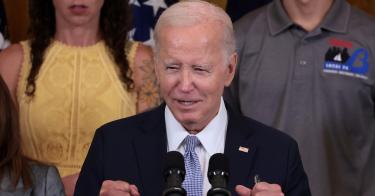If you’re puzzled as to how the Biden administration’s economic data can be so rosy while your own financial situation has deteriorated so quickly, you’re not alone.
Part of the explanation for this bizarre divergence lies in the quiet revision process that has consistently downgraded the official data after the initial headline got all the attention. In short, the economy is not as strong as we’ve been led to believe.
Perhaps the most notorious example this year has been the jobs numbers published by the Biden administration. Consider the newly released August jobs report. While the economy added 187,000 jobs last month, previous months were revised down by 110,000 jobs. That means 59% of the employment growth last month was jobs we thought we already had.
In fact, every monthly employment report this year has been revised down, meaning the economy has been adding fewer jobs than initially believed. Worse, the Bureau of Labor Statistics published its semiannual benchmark revisions showing jobs were overestimated by more than 300,000.
>>> Why the Unemployment Rate Is Much Higher Than It Seems
Between the downward adjustments for the monthly data and the semiannual benchmark, the number of jobs has been revised down by almost 700,000. That’s 30% of the jobs initially estimated to have been added this year. Adding insult to injury, government jobs were revised upward with the semiannual benchmark.
To be clear, jobs data are normally revised, and occasionally, several months in a row will be revised in the same direction, sometimes heavily. But this year stands out because so many of the statistics have consistently turned out to be worse than initially estimated.
Other labor market indicators have followed this pattern. The number of job openings, a proxy for labor demand, has not only fallen over the last several months but previous levels were also revised down. The latest estimate shows job openings are now 2 million below the initial figure for the start of the year.
And the problem goes beyond the labor sector to the general economy. The revised estimate for gross domestic product in the second quarter of the year removed an eighth of the previously estimated growth, falling from 2.4% to 2.1%. Investment and business income, in particular, are in bad shape.
That’s a bad omen. Private investment is the driver of economic growth and has been trending down since the first three months of 2022. Fixed investment, which excludes business inventories, has become flat since President Joe Biden took office.
Less investment means less growth, employment, and profits. Sure enough, the latest GDP report shows corporate profits in the second quarter of this year had their biggest annual drop since the government-imposed lockdowns in 2020.
>>> Biden Is Killing the American Dream of Homeownership
But it gets worse. While the private economy was revised down in the GDP report, the government was revised up, much like the jobs numbers. In other words, the government is growing faster, and the productive, real economy is growing slower. That’s especially true in the struggling housing industry.
Prospective homebuyers cannot afford current home prices at current interest rates. The monthly payment on a median-price home is more than twice what it was when Biden took office. Simultaneously, homebuilders’ cost indexes are near all-time highs, so they cannot afford to reduce selling prices.
The result is fewer homes built and sold. Unsurprisingly, new home sales this year have also seen major downward revisions, as has the number of houses under construction.
But like GDP, there are other broader economic indicators that are worse than initially reported. Industrial production has been so consistently revised down this year that all of the index’s originally estimated growth is gone. It’s now flat for 2023.
Whether it’s the jobs data or any other economic news, people would do well to be skeptical of these overly optimistic government reports. When almost half of the country thinks we’re in a recession, the blowout economic numbers seem out of place. As the adage goes, if it seems too good to be true, it is.
This piece originally appeared in Restoring America by the Washington Examiner




